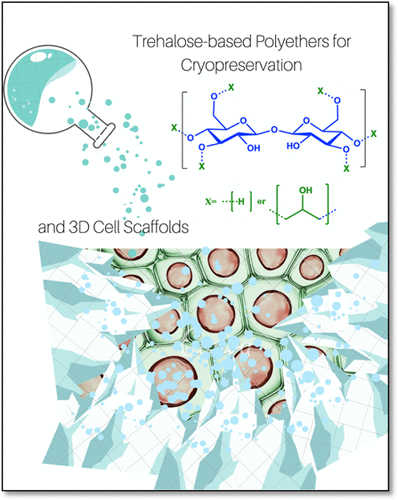当前位置:
X-MOL 学术
›
Biomacromolecules
›
论文详情
Our official English website, www.x-mol.net, welcomes your
feedback! (Note: you will need to create a separate account there.)
Trehalose-Based Polyethers for Cryopreservation and Three-Dimensional Cell Scaffolds.
Biomacromolecules ( IF 5.5 ) Pub Date : 2020-01-08 , DOI: 10.1021/acs.biomac.0c00018 Diana Diaz-Dussan 1 , Yi-Yang Peng 1 , Jayeeta Sengupta 1 , Rebecca Zabludowski 1 , Madeleine K Adam 2 , Jason P Acker 3, 4 , Robert N Ben 2 , Piyush Kumar 5 , Ravin Narain 1
Biomacromolecules ( IF 5.5 ) Pub Date : 2020-01-08 , DOI: 10.1021/acs.biomac.0c00018 Diana Diaz-Dussan 1 , Yi-Yang Peng 1 , Jayeeta Sengupta 1 , Rebecca Zabludowski 1 , Madeleine K Adam 2 , Jason P Acker 3, 4 , Robert N Ben 2 , Piyush Kumar 5 , Ravin Narain 1
Affiliation

|
The capability to slow ice growth and recrystallization is compulsory in the cryopreservation of cells and tissues to avoid injuries associated with the physical and chemical responses of freezing and thawing. Cryoprotective agents (CPAs) have been used to restrain cryoinjury and improve cell survival, but some of these compounds pose greater risks for the clinical application of cryopreserved cells due to their inherent toxicity. Trehalose is known for its unique physicochemical properties and its interaction with the phospholipids of the plasma membrane, which can reduce cell osmotic stress and stabilized the cryopreserved cells. Nonetheless, there has been a shortage of relevant studies on the synthesis of trehalose-based CPAs. We hereby report the synthesis and evaluation of a trehalose-based polymer and hydrogel and its use as a cryoprotectant and three-dimensional (3D) cell scaffold for cell encapsulation and organoid production. In vitro cytotoxicity studies with the trehalose-based polymers (poly(Tre-ECH)) demonstrated biocompatibility up to 100 mg/mL. High post-thaw cell membrane integrity and post-thaw cell plating efficiencies were achieved after 24 h of incubation with skin fibroblast, HeLa (cervical), and PC3 (prostate) cancer cell lines under both controlled-rate and ultrarapid freezing protocols. Differential scanning calorimetry and a splat cooling assay for the determination of ice recrystallization inhibition activity corroborated the unique properties of these trehalose-based polyethers as cryoprotectants. Furthermore, the ability to form hydrogels as 3D cell scaffolds encourages the use of these novel polymers in the development of cell organoids and cryopreservation platforms.
中文翻译:

用于冷冻保存和三维细胞支架的海藻糖基聚醚。
在细胞和组织的冷冻保存中,必须具备减缓冰生长和重结晶的能力,以避免与冷冻和解冻的物理和化学反应相关的损伤。冷冻保护剂 (CPAs) 已被用于抑制冷冻损伤和提高细胞存活率,但其中一些化合物由于其固有的毒性而对冷冻保存细胞的临床应用构成更大的风险。海藻糖以其独特的理化性质及其与质膜磷脂的相互作用而著称,可降低细胞渗透压并稳定冷冻保存的细胞。尽管如此,关于海藻糖基 CPAs 合成的相关研究还很缺乏。我们在此报告基于海藻糖的聚合物和水凝胶的合成和评估,及其作为冷冻保护剂和三维 (3D) 细胞支架用于细胞封装和类器官生产的用途。使用海藻糖基聚合物 (poly(Tre-ECH)) 进行的体外细胞毒性研究表明,生物相容性高达 100 mg/mL。在受控速率和超快速冷冻方案下,与皮肤成纤维细胞、HeLa(宫颈)和 PC3(前列腺)癌细胞系孵育 24 小时后,达到了高解冻后细胞膜完整性和解冻后细胞电镀效率。用于测定冰重结晶抑制活性的差示扫描量热法和飞溅冷却测定证实了这些基于海藻糖的聚醚作为冷冻保护剂的独特性质。此外,
更新日期:2020-01-22
中文翻译:

用于冷冻保存和三维细胞支架的海藻糖基聚醚。
在细胞和组织的冷冻保存中,必须具备减缓冰生长和重结晶的能力,以避免与冷冻和解冻的物理和化学反应相关的损伤。冷冻保护剂 (CPAs) 已被用于抑制冷冻损伤和提高细胞存活率,但其中一些化合物由于其固有的毒性而对冷冻保存细胞的临床应用构成更大的风险。海藻糖以其独特的理化性质及其与质膜磷脂的相互作用而著称,可降低细胞渗透压并稳定冷冻保存的细胞。尽管如此,关于海藻糖基 CPAs 合成的相关研究还很缺乏。我们在此报告基于海藻糖的聚合物和水凝胶的合成和评估,及其作为冷冻保护剂和三维 (3D) 细胞支架用于细胞封装和类器官生产的用途。使用海藻糖基聚合物 (poly(Tre-ECH)) 进行的体外细胞毒性研究表明,生物相容性高达 100 mg/mL。在受控速率和超快速冷冻方案下,与皮肤成纤维细胞、HeLa(宫颈)和 PC3(前列腺)癌细胞系孵育 24 小时后,达到了高解冻后细胞膜完整性和解冻后细胞电镀效率。用于测定冰重结晶抑制活性的差示扫描量热法和飞溅冷却测定证实了这些基于海藻糖的聚醚作为冷冻保护剂的独特性质。此外,











































 京公网安备 11010802027423号
京公网安备 11010802027423号